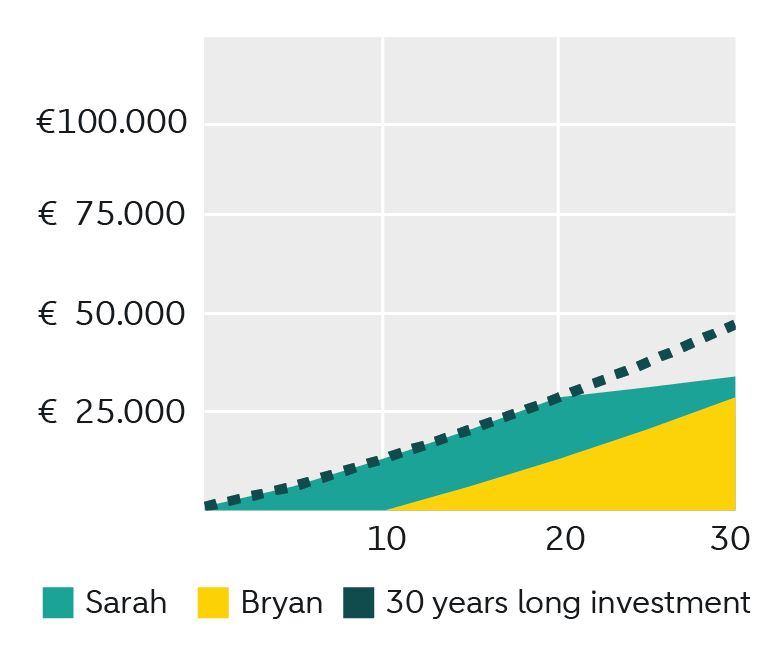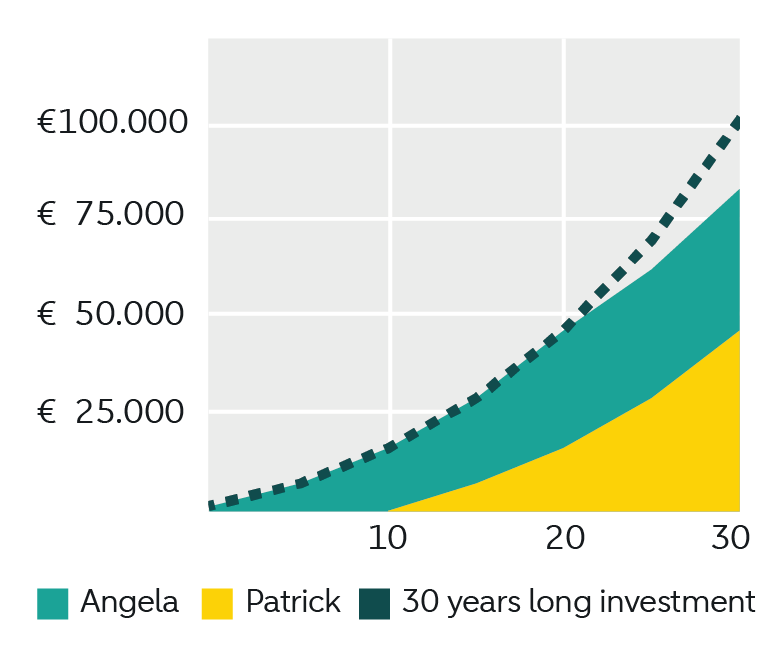Chat with chatbot Anna. Can't figure it out? Then an employee takes over the conversation.


Up to €1,000 bonus when you top up your pension
Give your pension savings a head start! Open a pension account by December 31, make your first deposit this year, and receive a bonus of €100 up to €1,000.
- Enjoy up to 49.5% tax relief
- Choose whether to save and/or invest for your pension
- Benefit from potential returns and the compound interest effect
Please note: investing involves risk. You could lose all or part of your initial investment.
One product: flexible saving and investing
Did you know that on average, Dutch people put aside €50,000 to top up their pension? That may sound like a lot, but the earlier you start, the longer you benefit from interest or returns, and the faster your money grows. This means that you need to put less money aside to achieve your pension goal. And you can also benefit from up to 49.5% tax relief on your investment.
Please note: investment involves risks. You could lose all or part of your investment.
All the info at a glance
Tax credit
- You can deduct money you put aside towards a pension top-up from your taxable income, but the amount you deposit may not exceed your annual margin (jaarruimte) and/or reserve space (reserveringsruimte).
- You will not be liable to pay wealth tax (for taxable income from savings and investments) on the amount you’ve accumulated in your pension account.
- You will, however, be liable to pay income tax and social security contributions on the payments you receive after retiring.
Interest and charges
Variable interest rate
The money you put aside for your pension in a pension account is intended for when you retire. The interest rate on the savings in the pension account is variable and currently stands at 1.70%. We reserve the right to change the interest rate. The interest you accrue will be transferred to your account on 1 January every year.
Costs
Opening fee
You pay a €49 opening fee when you open your pension account. At ABN AMRO, a pension account is called the Pensioenaanvulling.
Pension investment (related) fees
Pension investment is subject to a service fee charged as a fixed percentage of the value of your investments. You will be charged 25% of the annual fee on a quarterly basis. There is also a fee to cover investment funds’ expenses, i.e. a fund’s ongoing fees and transaction fees. Further details of service fee are provided on the fee sheet.
Deposits
It's up to you to decide what money you want to put into your pension account:
- the amount of your annual margin or any reserve space you have, and/or
- a bank savings product or life insurance policy with another bank or insurance company, and/or
- your business discontinuation profit or old-age reserve.
If you already have a pension account with us, you can, for example, opt to deposit an amount automatically every month. You won’t have to think about it and you’ll accrue extra pension for later without noticing.
You must just make sure that the amount you deposit into your pension account every month or year stays within your annual or reserve space. You can then deduct this amount from your taxable income on your tax return.
Withdrawals
The pension account is a special account that does, in principle, not allow any withdrawals by anyone before you retire.
If you do want to withdraw all the money in the account as a lump sum, this is called ‘commutation’. It’s important to think carefully about this, as it is subject to a commutation fee. On top of that, the Dutch Tax and Customs Administration may also impose a penalty for the commutation amount. If you’re considering withdrawing money, please get in touch.
If you decide to transfer the money in your ABN AMRO pension account to another bank or insurer before your state retirement age, you will be charged €150.
Your money is safe
The funds in your pension savings account are covered by the Dutch Deposit Guarantee Scheme, meaning that your savings are automatically protected if the bank goes bankrupt, up to a maximum of €100,000 per person. The protection applies to the total amount you have (in all your accounts together) with ABN AMRO Bank N.V.
Banks are required to abide by the asset segregation requirement. This means that your investments cannot be classed as part of your assets. You are, however, eligible for the investor compensation scheme. For more information about this scheme, search for ‘Investor compensation’ on the English pages of the website of the Dutch central bank DNB.
Terms & conditions
Take a look at our terms and conditions:
- Terms and conditions pension account (in Dutch)
- Additional terms and conditions pension savings account (in Dutch)
- General investment terms and conditions
- Additional terms and conditions pension investment account (in Dutch)
Important information:
Tax credit
- You can deduct money you put aside towards a pension top-up from your taxable income, but the amount you deposit may not exceed your annual margin (jaarruimte) and/or reserve space (reserveringsruimte).
- You will not be liable to pay wealth tax (for taxable income from savings and investments) on the amount you’ve accumulated in your pension account.
- You will, however, be liable to pay income tax and social security contributions on the payments you receive after retiring.
Interest and charges
Variable interest rate
The money you put aside for your pension in a pension account is intended for when you retire. The interest rate on the savings in the pension account is variable and currently stands at 1.70%. We reserve the right to change the interest rate. The interest you accrue will be transferred to your account on 1 January every year.
Costs
Opening fee
You pay a €49 opening fee when you open your pension account. At ABN AMRO, a pension account is called the Pensioenaanvulling.
Pension investment (related) fees
Pension investment is subject to a service fee charged as a fixed percentage of the value of your investments. You will be charged 25% of the annual fee on a quarterly basis. There is also a fee to cover investment funds’ expenses, i.e. a fund’s ongoing fees and transaction fees. Further details of service fee are provided on the fee sheet.
Deposits
It's up to you to decide what money you want to put into your pension account:
- the amount of your annual margin or any reserve space you have, and/or
- a bank savings product or life insurance policy with another bank or insurance company, and/or
- your business discontinuation profit or old-age reserve.
If you already have a pension account with us, you can, for example, opt to deposit an amount automatically every month. You won’t have to think about it and you’ll accrue extra pension for later without noticing.
You must just make sure that the amount you deposit into your pension account every month or year stays within your annual or reserve space. You can then deduct this amount from your taxable income on your tax return.
Withdrawals
The pension account is a special account that does, in principle, not allow any withdrawals by anyone before you retire.
If you do want to withdraw all the money in the account as a lump sum, this is called ‘commutation’. It’s important to think carefully about this, as it is subject to a commutation fee. On top of that, the Dutch Tax and Customs Administration may also impose a penalty for the commutation amount. If you’re considering withdrawing money, please get in touch.
If you decide to transfer the money in your ABN AMRO pension account to another bank or insurer before your state retirement age, you will be charged €150.
Your money is safe
The funds in your pension savings account are covered by the Dutch Deposit Guarantee Scheme, meaning that your savings are automatically protected if the bank goes bankrupt, up to a maximum of €100,000 per person. The protection applies to the total amount you have (in all your accounts together) with ABN AMRO Bank N.V.
Banks are required to abide by the asset segregation requirement. This means that your investments cannot be classed as part of your assets. You are, however, eligible for the investor compensation scheme. For more information about this scheme, search for ‘Investor compensation’ on the English pages of the website of the Dutch central bank DNB.
Terms & conditions
Take a look at our terms and conditions:
- Terms and conditions pension account (in Dutch)
- Additional terms and conditions pension savings account (in Dutch)
- General investment terms and conditions
- Additional terms and conditions pension investment account (in Dutch)
Important information:
“If you start early, you’ll benefit for longer from interest-on-interest or potential returns. This can make all the difference.”

Joelle - Income & Wealth adviser
The earlier you start, the longer your returns can work for you
Pension savings

Sarah and Bryan both start saving for their pensions. They each save €100 per month for 20 years. In this example, they receive an annual interest rate of 1.70% (the current variable rate).
- Sarah saves €100 per month for 20 years. After that, she stops saving but leaves the money untouched for another 10 years. After 30 years, Sarah has approximately €34,000.
- Bryan starts saving 10 years later and also saves €100 per month for 20 years. After 30 years, Bryan has approximately €29,000.
Conclusion: In this example, Sarah has saved €5,000 more with the same contributions. This is due to the effect of compound interest.
The graph is calculated using the current variable interest rate of 1.70%. This percentage is subject to change.
Pension investment

Angela and Patrick both start investing for their pensions. They contribute €100 per month for 20 years. In this example, they receive a hypothetical return of 6% per year.
- Angela invests €100 per month for 20 years. After that, she stops contributing but leaves the money invested for another 10 years. After 30 years, Angela has approximately €83,000.
- Patrick, on the other hand, waits 10 years before starting to invest and then contributes €100 per month for 20 years. After 30 years, Patrick has approximately €46,000.
Conclusion: In this example, Angela has built up €37,000 more with the same total contribution. This is due to the compound returns.
Note: This graph is an indication of the effect of returns over the long term and does not represent future results. No rights can be derived from this.

Let your pension grow automatically
If you want to top up your pension but don’t want to spend too much time and energy thinking about it, set up a periodic deposit. If you want to save and invest, simply state the split you want when you set up the periodic deposit. For example: 40% saving and 60% investment. Everything will then be processed for you automatically. Just sit back and imagine your beautiful garden or that dream trip, thanks to the extra pension you’re building up now!
Frequently asked questions about pensions
How do I know how much pension I’ll need when I retire?
It’s commonly agreed that you’ll need about 70% of your current income when you retire. This covers your housing costs, day-to-day expenses, travel and your hobbies.
How much pension you’ll really need varies from person to person. Have you almost paid off your mortgage, for example, or do you rent your home? And do you intend to stay at home once you retire, or are you planning long-distance trips? To find out where you stand, complete the Nibud ‘Pensioenschijf van 5’ pension questionnaire (in Dutch).
Once you’ve worked out how much pension you’ll need when you retire, do the pension check. This shows you exactly how much state pension and private pension you can expect. If this doesn’t tally with what you think you’ll need, it might be sensible to start saving money for later.
How can I top up my pension with tax relief?
If you build up additional pension in a pension account, you may be eligible for tax benefits. You can get 36% to 49.5% of your investment back through your tax return. This tax credit is conditional on your deposits staying below a certain limit known as your annual margin. The amount of your annual margin depends on your income and other factors. To help you understand how the annual margin and tax relief works, we’ve put together a sample calculation for you. Let’s say your annual income is €40,000:
- In 2025, you pay 37% tax on your income.
- You deposit €100 per month into your pension account.
- You can claim back €37 (i.e. 37%) of this €100.
- So in one year, you’ll have saved and/or invested €1,200 (within your annual margin).
- Your total tax credit will be €444.
How do I open a pension account?
- We first ask a few questions to check that saving or investing for a pension top-up is right for you.
- Read the terms and conditions and sign the agreement digitally.
- Your pension account will then have been opened and you can start saving right away!
- If you’re also planning to invest, you can request this option right away.
What’s best: saving or investing for my pension?
Different people will make different decisions about pension saving or pension investing, but luckily, if you open a pension account, you don’t have to choose between the two. If you want, you can save and invest for your pension, for example 60% investments and 40% savings. This gives you a chance of earning higher returns with part of your pension capital, while you enjoy the peace of mind of saving with the other part.
If you later decide you want to save or invest more, that’s no problem at all, as you can change the split whenever and as often as you like. And it won’t cost you anything extra. The new split will be applied from your next deposit.
What are the pros and cons of a pension account?
The biggest advantage of saving or investing in a pension account is the possible tax relief of up to 49.5% on your income tax. This benefit is not available with a regular savings or investment account.
A disadvantage of a pension account is that you can’t simply withdraw your money, as the account is blocked until you reach state retirement age. This is why it’s sensible only to put aside money that you don’t need. But don’t worry about what happens if you become incapacitated for work, because under certain conditions, you’ll then be able to withdraw the money from your pension account.
Having said this, not being able to easily access your money can also be an advantage, as it prevents you from being tempted to spend your savings. And if you opt to make automatic periodic deposits for your pension, your capital will grow without you having to lift a finger. What better retirement present could you possibly give yourself?
How can I switch my pension account to ABN AMRO?
If you’ve been building up a top-up pension with another bank or insurance company, you can switch to ABN AMRO and continue saving or investing. We’ll be happy to help.
Investing involves risk
You should only invest for your pension using money you can spare and keep your investments within your annual margin. Investing involves risk. You could lose all or part of your initial investment. It is important to be aware of this.
Do you need help?
Make an appointment

Leave your details and we will call you to schedule an appointment.



